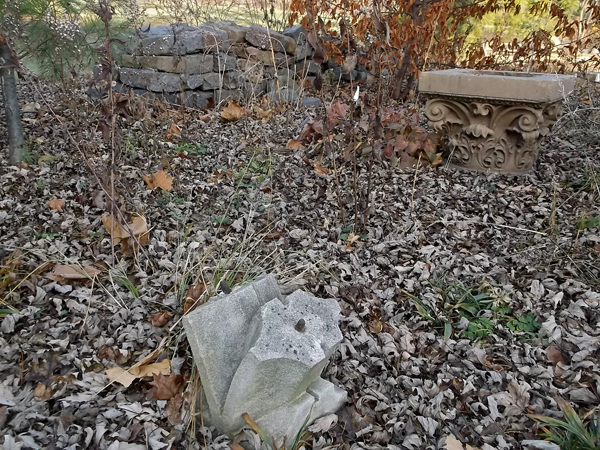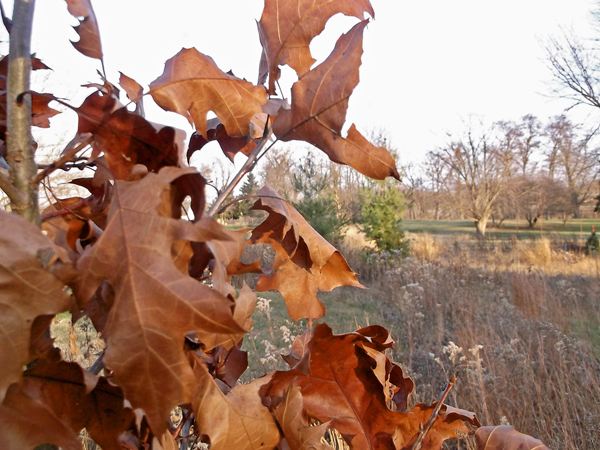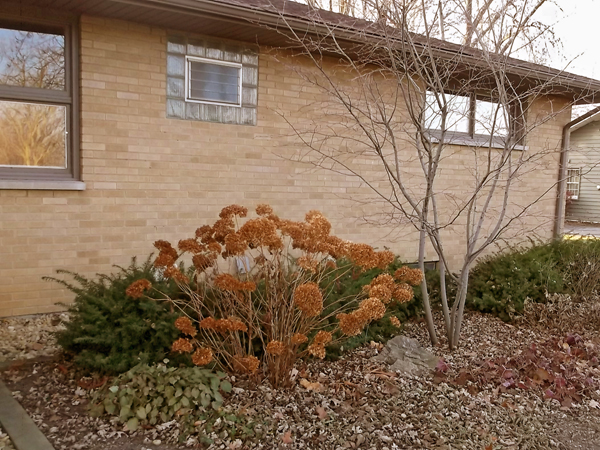
Milkweed pods catch the rays of a setting sun in my backyard meadow.
“If you’ve got just lawn grass, you’ve got nothing,” said Mace Vaughan of the Xerces Society, a leading organization in insect conservation. But as soon as you create a front yard wildflower meadow you go from an occasional honeybee to a lawn that might be full of 20 or 30 species of bees and butterflies and monarchs.”
New York Times, Jim Robbins, 22 November 2013
When I first moved into my home in the fall of 2005, I was excited about having a big yard, but the yard, as it was, was all mowed lawn - not very exciting at all. When I read the article, The Year the Monarch Didn't Appear, by Jim Robbins last week, about the decline in Monarch butterfly populations, it made me think of my yard, both how it was, barren, and how, when I look out my windows now, I see variety and life, activity, beauty, nature.
The Front Yard

My home, in the winter of 2006, shortly after I moved in.
My housewarming present from my father was a small seedling oak that he had dug from his yard, my first planting in my yard. And so it began. During the first spring in my home, I started marking out planting beds, laid out my vegetable garden, and planted more seedling oaks and other trees native to my region. All the trees were started from seed collected on, or adjacent to, my parent's property, a remnant of second growth oak woods.

Today, the fall of 2013


A young Red Oak (Quercus rubra), in the foreground, will take over as the short lived Silver Maples decline.

January of 2006

Today, November of 2013
The narrow strip of land between my driveway and my neighbor's driveway receives plenty of sun, why mow grass when our native prairie grasses and flowers are so incredibly beautiful and would do so well in this location? This garden has evolved quickly from a prairie flower garden with Black-eyed Susans, Pale Purple Coneflowers, Prairie Dock, Orange Milkweed, and Prairie Dropseed, to a more mature garden of mostly Midwest native grasses and trees, including Winged Sumac, Red Oak, and Hawthorn. Prairie Dropseed grass (Sporobolis heterolepis) and a young Hawthorn (Crataegus sp.) can be seen in the above photo, with a 'Twilite Prairie Blues' Prairie Indigo just behind. The larger scale of these plants works well for this open space.
The Back Yard

Shortly after I moved in, January 2006. The one foot tall caged oak (a gift from my father) to the right of the clothesline was my first planting.
"Around the world people have replaced diverse natural habitat with the biological deserts that are roads, parking lots and bluegrass lawns. Meanwhile, the plants people choose for their yards are appealing for showy colors or shapes, not for their ecological role. Studies show that native oak trees in the mid-Atlantic states host as many as 537 species of caterpillars, which are important food for birds and other insects. Willows come in second with 456 species. Ginkgo, on the other hand, which is not native, supports three species, and zelkova, an exotic plant used to replace elm trees that died from disease, supports none. So the shelves are nearly bare for bugs and birds."
New York Times, Jim Robbins, 22 November 2013

That little oak is now over ten feet tall and it has the company of over thirty other young oaks.
 My Yard in September of 2013:
My Yard in September of 2013:


Old Chicago street pavers stacked as sculpture until they are needed in the garden for another purpose.

More granite pavers waiting to be artfully stacked

Some of the 100 year old granite pavers were used to create a retaining wall. The Maindengrass (Miscanthus sp.) while not native, creates an effective living screen.

A trilobite fossil was found in a piece of salvaged limestone while building a low retaining wall.

The remaining granite pavers may be used to replace the badly settled walkway along the garage.

It's not hard to tell where my property stops. Eight years ago both sides of the photo looked the same.

Salvaged building materials can make for interesting garden art.

This garden chair was found in a creek bed, now it's sculpture under the branches of the old apple tree.

Other found objects were assembled to create a steampunk effect in the garden

Stacked bits of driftwood show the passing of time.

Rocks are my favorite form of sculpture, stacked, they show a human presence, evoking ancient rituals.

Souvenirs from vacations do not have to be T-shirts and ceramic mugs, this Deborah Silver sculpture reminds me of my visit with her at her Detroit Garden Works.

Silhouettes on the winter sky.




Mowed lawn for fifty years, now a prairie meadow, mowed once a year in March.

One of Illinois' native Opuntia cactus showing this season's fruit, "prickly pear"


Standing in an oasis, I see the desert beyond

The remnants of Stiff Goldenrod seedheads - the flowers may be gone, but the beauty has not.


Little six foot oak, grew two feet this season. Reach for the sky mighty oak.

Pasture rose shows off its seasonal decorations

Mounded Prairie Dropseed grass surrounded by taller Little Bluestem grass in my backyard meadow

Poverty Oats grass, how beautiful you are.



Orange Milkweed pods spreading seeds and giving hope to future Monarch visitors

Solomon Seal fruits, understated beauty

Mountain Mint, seed heads

American Hazelnut catkins in November, ready for a warm spring day to release their pollen.

'Annabelle' Hydrangea, with Serviceberry trees, combine well with a few non-native evergreens including the groundcover Epimedium and Japanese yew shrubs .. makes a nice winter garden composition.




 My Yard in September of 2013:
My Yard in September of 2013:







































